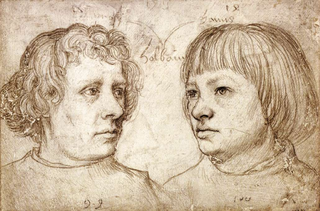
Ambrosius Holbein was a German and later a Swiss artist in painting, drawing, and printmaking. He was the elder brother, by about three years, of Hans Holbein the Younger, but he appears to have died in his mid-twenties, leaving behind only a small body of work.

Hans Holbein the Younger was a German-Swiss people painter and printmaker who worked in a Northern Renaissance style, and is considered one of the greatest portraitists of the 16th century. He also produced religious art, satire, and Reformation propaganda, and he made a significant contribution to the history of book design. He is called "the Younger" to distinguish him from his father Hans Holbein the Elder, an accomplished painter of the Late Gothic school.

Lais of Corinth was a famous hetaira or courtesan of ancient Greece, who was probably born in Corinth. She shared a name with the younger hetaira Lais of Hyccara; as ancient authors often confused them or did not indicate which one they referred to, the two women became inextricably linked. Lais lived during the Peloponnesian War and was said to be the most beautiful woman of her time. Among her clients were the philosopher Aristippus and the Olympic champion Eubotas of Cyrene.

Johann Froben, in Latin: Johannes Frobenius, was a famous printer, publisher and learned Renaissance humanist in Basel. He was a close friend of Erasmus and cooperated closely with Hans Holbein the Younger. He made Basel one of the world's leading centres of the book trade. He passed his printing business on to his son, Hieronymus, and grandson, Ambrosius Frobenius.
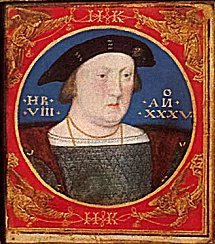
Lucas Horenbout, often called Hornebolte in England, was a Flemish artist who moved to England in the mid-1520s and worked there as "King's Painter" and court miniaturist to King Henry VIII from 1525 until his death. He was trained in the final phase of Netherlandish illuminated manuscript painting, in which his father Gerard was an important figure, and was the founding painter of the long and distinct English tradition of portrait miniature painting. He has been suggested as the Master of the Cast Shadow Workshop, who produced royal portraits on panel in the 1520s or 1530s.

The artists of the Tudor court are the painters and limners engaged by the monarchs of England's Tudor dynasty and their courtiers between 1485 and 1603, from the reign of Henry VII to the death of Elizabeth I.

The Kunstmuseum Basel houses the oldest public art collection in the world and is generally considered to be the most important museum of art in Switzerland. It is listed as a heritage site of national significance.
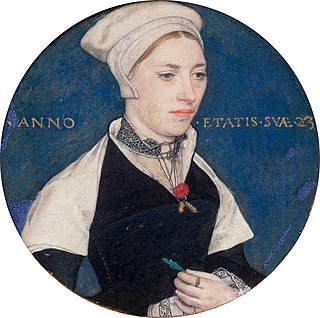
Jane Small (c. 1518–1602) was a daughter of Christopher Pemberton, a Northamptonshire gentleman. She is well known as the subject of a portrait miniature by the famous 16th-century German artist Hans Holbein the Younger, painted about 1540. Holbein was known as a painter of the English court where his paintings included those of King Henry VIII and several of his wives.

Catherine Howard, also spelt Katheryn Howard, was Queen of England from 1540 until 1541 as the fifth wife of Henry VIII. She was the daughter of Lord Edmund Howard and Joyce Culpeper, a cousin to Anne Boleyn, and the niece of Thomas Howard, 3rd Duke of Norfolk. Thomas Howard was a prominent politician at Henry's court, and he secured her a place in the household of Henry's fourth wife, Anne of Cleves, where she caught the King's interest. She married him on 28 July 1540 at Oatlands Palace in Surrey, just 19 days after the annulment of his marriage to Anne. He was 49, and she was between 15 and 21 years old.

The Body of the Dead Christ in the Tomb is an oil and tempera on limewood painting created by the German artist and printmaker Hans Holbein the Younger between 1520 and 1522.

Venus and Amor is painting by the so-called "Venus Painter" of Hans Holbein the Youngers workshop and is conserved in the Kunstmuseum Basel, Switzerland. It was assumed for a long time to be painting by Hans Holbein the Younger, but research showed that this could not be possible. It was discovered that the painter had used a sort of a carbon paper with the contours of the already existing Laïs and used it to transfer those contours in reverse on the new portrait he was to paint of Venus. As the portrait of Laïs is dated with 1526, the year of Hans Holbeins departure from Basel, it is assumed that the work has been painted between 1526 and 1528, the years Holbein stayed in London. The painting depicts the Roman goddess of love, Venus, with her son Amor (Cupid) and the model is believed to be either Magdalena Offenburg or her daughter Dorothea. They are shown in front of a large hanging green curtain and behind a low parapet. Venus is depicted with an open gesture and sincere gaze. Cupid is seen climbing onto the parapet while holding love's arrow in his left hand. He has red-orange hair, rendered in the same colouring and tone of the rich cloth sleeves covering his mother's upper arms.

The Calumny of Apelles is a panel painting in tempera by the Italian Renaissance painter Sandro Botticelli. Based on the description of a lost ancient painting by Apelles, the work was completed in about 1494–95, and is now in the Uffizi, Florence.

The Basel Town Hall is a 500-year-old building dominating the Marktplatz in Basel, Switzerland.
The Amerbach Cabinet was a collection of artifacts, paintings, libraries, assembled by members of the Amerbach family, most notably by the two law professors of the University of Basel, Bonifacius Amerbach and his son Basilius Amerbach the Younger.

Hans Holbein the Younger painted the Portrait of Erasmus of Rotterdam several times, and his paintings were much copied, at the time and later. It is difficult to disentangle Holbein's original work from that of his workshop and other copyists. Possibly five largely original versions survive, as well as a number of drawings made as studies.

Basilius Amerbach was a lawyer, professor and collector from Basel. He was the only son of Bonifacius Amerbach.
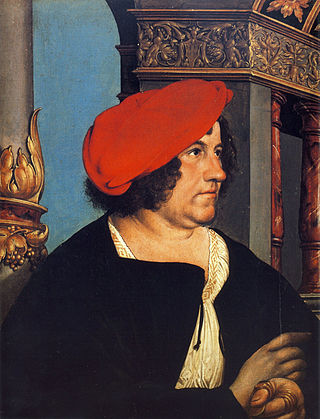
The Double Portrait of Jakob Meyer zum Hasen and Dorothea Kannengießer is a 1516 oil-on-limewood panel painting by Hans Holbein the Younger. The two panels were commissioned by Jakob Meyer zum Hasen, mayor of Basel, and show him and his second wife Dorothea Kannengießer. The occasion for the portrait could be Meyer zum Hasen's election as the mayor the same year. Holbein was eighteen years old at the time and had arrived in Basel together with his brother Ambrosius only in 1515. He signed with the letters HH. He received the right to sign with his full name in 1519, when he was accepted as a member of the painters' guild of Basel.
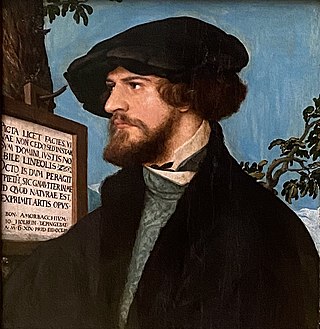
Bonifacius Amerbach was a jurist, scholar, an influential humanist and the rector of the University of Basel for several terms.

The Portrait of Bonifacius Amerbach is a painting by the German master of the Renaissance Hans Holbein the Younger. It is deposited in the Basler Kunstmuseum as part of the Amerbach Cabinet. It is painted in tempera on pinewood and measures 29 cm x 27 cm.

Portrait of the Artist's Family is a portrait of the family of the painter Hans Holbein the Younger by the artist himself. It depicts Holbein's wife Elsbeth Binzenstock, their son Philipp and their daughter Katharina. Holbein painted it during his stay in Basel after his return from England. It was painted, between 1528 and 1529, on paper and glued on wood.



















